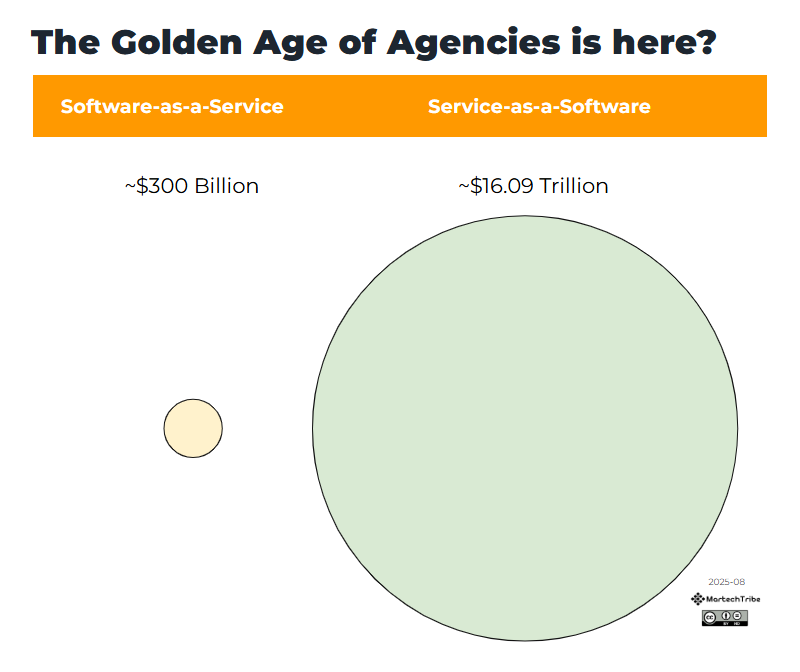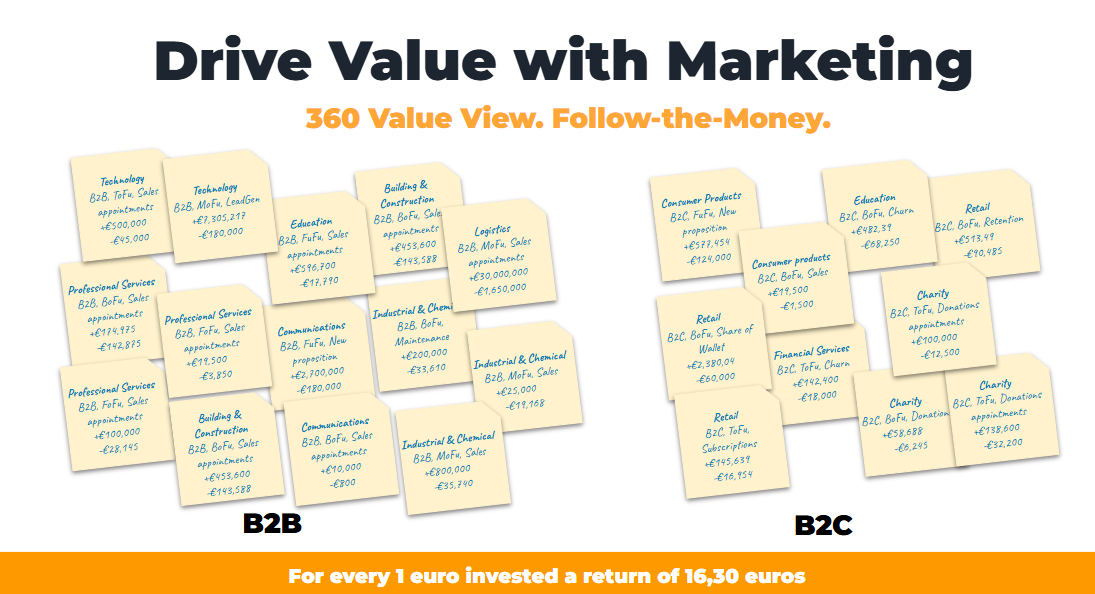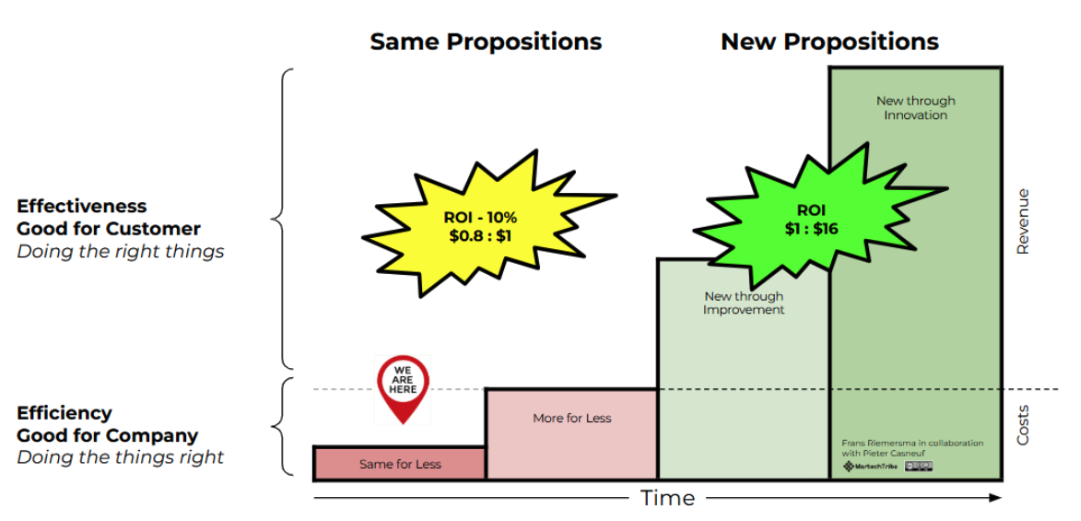.jpeg)
We found a way to navigate the 474 Marketing Management tools of the Martech Supergraphic. By analyzing 200+ real-life marketing technology stacks, we found that marketers’ first priority is a smooth collaboration in terms of file sharing and team level communications. For next level collaboration, agile & project tools are introduced. Finally, vendor analysis helps to equip the team with the best & latest tools.
This blog post on Management tools is part of a series. Other categories in the Martech Supergraphic are discussed in detail here:
- Ads & Promotions
- Content & Experience
- Social & Relationships
- Commerce & Sales
- Data
- Management – you found it!

4 Marketing Management ‘Jobs to be Done’ are Key to Marketing Success
The management of marketing is almost a separate discipline in itself. The purpose of management tools in marketing is to make sure campaigns & projects stay on track in terms of time, resources, targets and budget. This area is also know as marketing operations or resource management and helps marketing teams run campaigns, generate leads, and gain insights. For operations, it’s about the optimization and streamlining of the processes across the other five Martech Supergraphic categories.
The subcategory names of the Martech Supergraphic are close to describing marketing tasks, processes or ‘jobs to be done’. They can be a starting point for learning to navigate the Supergraphic.

The individual tool names of the Martech Supergraphic can tell us which tools are dominant, and which of their capabilities are vital for running marketing activities.

When marketers want to augment their management handling capability, the first thing they do is implement Collaboration tools. Since this area is so popular, we felt inclined to split it up. The first focus of marketers in terms of collaboration is with sharing Files & Documents. In the slipstream of documents, managers need to facilitate internal Communication. Agile & Lean Management and Projects & Workflow tools support the smooth collaboration on marketing activities. To improve their martech stack, marketers consult Vendor Analysis tools… or they read very very interesting blog posts about it, as it were.
1a. Collaboration - Document Management
Introduction
File and document management tools are used to track, manage and store document versions created and modified by different users. The files & documents are focused on enabling the marketing department and letting work, communication and knowledge flow, for strategic plans, briefings, creative assets, invoices, best practices, standards, etc.
The nature and purpose of the documents we’re talking about in the Data category are not the same as the brand & marketing assets managed in Digital Asset Management systems, or the sales content managed in Sales Enablement tools. That said, we do not exclude that marketing and sales assets also can be managed as files & documents. The opposite can also happen.
According to our stack population, Dropbox, Google Drive and Box are marketers’ most popular tools to run their daily activities with. All three tools provide secure file sharing and cloud storage. It allows (marketing) teams to iterate, comment and share instantly via web or mobile. It also includes deleted file recovery, large file transfers as well as file sync capabilities with local hard drives or servers.
Where formerly marketers had to perform a balancing act between handling the creative on Macs and use MS Office for coordination documents like briefings, marketing plans, campaign evaluations, etc., nowadays these two universes have practically grown together. Management tools mentioned in this Supergraphic category are very popular. If we combine the office tools such as Google Sheets and (parts of) G-Suite, MS Excel and MS Office, they would share the first rank with Slack in the Management category.
Invision is a different category. The Invision app is a digital product design platform. Just like you would work on documents collaboratively, Invision allows web and mobile marketers, as well as product managers, to create prototypes of online designs by managing html files centrally. Especially with the stack population in mind, which mainly comprises B2B tech companies, we can imagine that Invision plays a pivotal role for their product departments.
1b. Collaboration - Communication tools
Introduction
Communication tools allow teams to stay ‘in the know’. To keep the stakeholders in the loop, vital information is not only shared in the form of documents, but also directly via tools. The advantage is that conversation threads are tracked for both internal teams, as well as suppliers and agencies.
Marketing teams do not only come together in meetings to align, but they also use tools to share campaign information and updates via a wide variety of tools.
Slack tops this list of tools by allowing members of a specific group send text messages, share files and make calls. The work can be grouped in channels. The powerful integrations allows for pulling files, emails, (instant) messages and updates from other tools. By doing so, Slack brings the conversation to one place and makes conversations searchable.
Google+ is the second most popular tool in this area. Google+ sought to learn from the way people interact offline and combine it with the intuitiveness of the interactions of social media (Twitter, Facebook, Pinterest, etc.) to deliver real-life sharing and communications for co-workers, customers, and others inside and outside an organization. However, the tool was discontinued in April 2019, at least for personal use. Google+ continues to be available for work or education.
Slack, Skype, Join.me and Gotomeeting offer largely the same services today. Whereas Slack added calls to their messaging and file sharing capabilities, Skype, Join.me and Gotomeeting started with calls and Voice over IP (VOIP) first and then added file sharing and messaging.
Skype provides video chat and voice calls between computers, tablets, mobile phones over the Internet. Skype additionally provides instant messaging services, text messaging, as well as video, audio and images & screen sharing.
Join.me and Gotomeeting are both owned by LogMeIn Inc. GoToMeeting and Join.me support online meetings, desktop sharings, and video conferencing to enable teams to meet. Like Skype, they offer video conferencing by phone or internet (VoIP).
Many of these tools offer integrations with CRM systems, like Salesforce, for collaboration purposes, not necessarily to reach out to prospects and customers. The integrations allow sales and service reps to retrieve customer data, or sharing messages without leaving Salesforce.
2. Agile & Lean Management + Projects & Workflow tools
Introduction
The alignment and management of marketing activities is covered by project management-like tools. Two ends of the same stick are agile and project management tools.
File sharing and multiple communication threads can cloud the overview of the overall progress of campaigns and marketing activities. Tracking tasks, campaign dates and marketing budgets in multiple spreadsheets or presentations also hamper marketers to get the most out of their budget. Therefore some marketers tools add to their stacks to orchestrate marketing activities end-to-end and across the board.
Looking at the four most popular tools in this area, we decided to combine two subcategories: Agile & Lean Management and Projects & Workflows. Some tools originate in one subcategory and added features of the other, and vice versa.
In essence, all four Agile tools in our graph offer ‘waterfall’ project management functionalities, as well as agile and scrum capabilities. Waterfall project management features planning that is driven by the campaign-live date in the form of calendars and Gantt charts. Agile, or predominantly scrum capabilities, are covered in the shape of Kanban boards, lists & cards, and burndown charts.
Agile and scrum practices have been applied in the marketing space too. It has been particularly successful in the areas that resemble software development, such as setting up and managing digital marketing products like CMSs, websites, landing pages, microsites, product sites, etc. In areas such as managing campaigns and aligning marketing activities, the agile (software) principles do not always apply.
Jira and Trello are both owned by Atlassian. Jira and Trello are used to plan, track, and manage agile projects. Jira is the only tool mentioned here that has its origins in software development. Looking at our stack population, largely B2B technology companies, we expect that JIRA started in software development and then was rolled out in the rest of the company, like marketing.
Jira also offers the waterfall project management features in the shape of Gantt charts. Trello allows for gantt charts too but only by integrating third party tools, called Power-ups. Both tools allow users to add files, comments, votes, checklist, etc.
Asana and Smartsheet offer Gantt charts as well as Kanban capabilities to plan, track, automate, and report on work. What sets them apart is the fact that these tools help to manage central (campaign) calendars, and to track spend and budget. This helps to more easily assign tasks and track project progress, and to reduce the shuffling between spreadsheets, email, and other tools.
3. Vendor Analysis tools
Introduction
Vendor analysis tools help Marketing (Technology) Managers with the assessment of current or new tools to support all the Martech Supergraphic categories.
With Martech becoming more popular and democratized, marketing managers, or even the emerging role of martech managers, feel the need to learn about new tools and to get the most out of their existing tooling.
G2Crowd and TrustRadius are the most popular places to go.G2 crowd is an online platform business software and services are compared based on user ratings, aggregated reviews and social data. The platform is, in addition to CRM, ERP, HR, CAD, PDM, also covering marketing software.
TrustRadius is a community of professionals sharing software reviews, and best practices for business technology, serving both buyers and vendors. Trustradius helps buyers to make product decisions based on reviews.
How to walk the four stages of Marketing Management ‘Jobs to be done’
To summarize…
- Track information and let the knowledge flow with Document Management (1a)
- Keep internal and external stakeholders in the loop with Communication tools (1b)
- Manage and align marketing activities with Agile & Lean Management + Projects & Workflow tools (2)
- Assess current and new tools to augment martech capacity with Vendor Analysis tools (3)
So, that is it for this Supergraphic category. If you are ready to dive into one final, all encompassing article spanning all 6 Martech Supergraphic categories, stay tuned!

If you want to contribute to the ongoing Martech Benchmark research, submit your stack now. You’ll receive an automatically generated, personalized report in minutes.
Thanks to…
Lastly, a huge thank you to our magnificent and ever-growing review panel.
Annika Werner, Carlos Doughty, Carmine Basil, Danielle Balestra, Doug Kessler, Hans van der Meulen, Huib Stad, Iban Rios, Julia Valentine, Kirsten Wildberger, Maarten Rijswijk, Marinka Eekman, Mark Wakelin, Matthieu Vermeulen, Mayer Becker, Mayur Soni, Michael Sweeney, Moni Oloyede, Nikki Kyriakopoulos, Odd Morten Sørensen, Peter Krmpotic, Peter Meijers, Rene Steiner, Roel Seegers, Samuel Schmitt, Scott Sweeney, Simon Daniels, Sree Vattikuti, Stacy Falkman, Travis Martin, Venkatesha(Venky) Murthy,Gary Katz, Julie Legrand.
About this research
The Marketing Technology Landscape contains 7,040 tools spread over 50 subcategories, which are represented in the Martech Supergraphic. This is simply too much to take in. If we are not careful, marketers might think the field of martech is too complicated altogether, and might not capitalize on its huge potential.
In six blog posts, we’ll try to discover which stages companies usually go through as they improve their stack. We’ll explore which tools other companies are using, so you can identify how your company’s stack compares – where it overlaps and where gaps are. If you are over-equipped in a specific area, you might be able to cut out some tools and accompanying costs. And if you are under-equipped, you have a great opportunity to improve your marketing efforts.
If you are interested in how the martech market has developed over the years, including the data category, read all about Martech consolidation here.
When reading through the research results, please bear in mind that the sample is leaning towards SME B2B technology companies with between 25 to 1000 staff members and an annual turnover of 10 to 50 million dollars.
Want to contribute to the ongoing Martech Benchmark research? Submit your stack now.
Important note: We see our stack population of 200 Martech stacks as a first indicator for which type of tools marketers use or need. We aim to distill a ‘Martech roadmap’ that outlines which tools marketers need to improve their Martech capability over time, as their company develops.
Please understand that our research population is mainly covering SME B2B technology companies with between 25-1,000 staff members and yearly turnover of 10-50 million dollars. We believe our research population is still too small to consider our results as a definitive answer on which tools are best. Rather, we encourage you to investigate the breath of alternative tools within (sub)categories.




